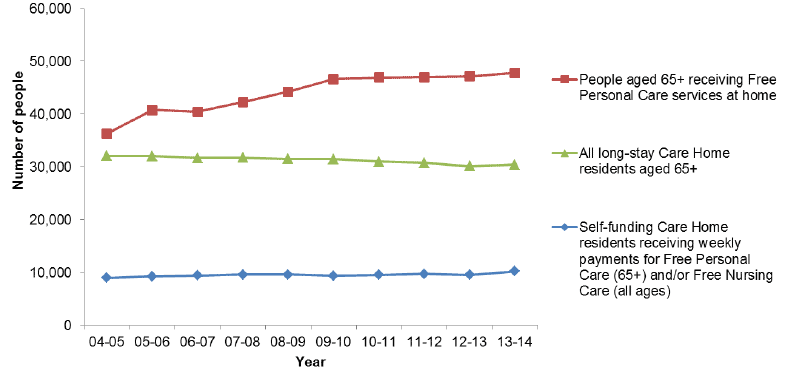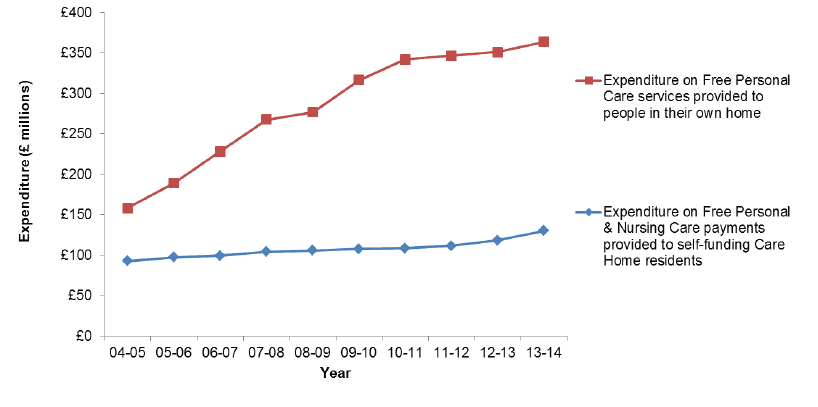Free Personal And Nursing Care, Scotland, 2013-14
This Statistics Release presents the latest figures (financial year 2013-14) for expenditure on Free Personal and Nursing Care (FPNC), which was introduced in Scotland in 2002. This release presents information from a variety of sources to give a picture of:
the number of people benefiting from free personal care and free nursing care in Scotland
how much Local Authorities spend on personal care services
2. Main points
Number of clients
Around 78,000 people in Scotland benefit from Free Personal Care, with more than 30,000 people in Care Homes and nearly 48,000 people living in their own home. Over 10,000 self-funding Care Home residents receive weekly payments for Free Personal Care (ages 65+) and/or Free Nursing Care (all ages).
Figure 1: People receiving FPNC (thousands)

Care Homes
The overall number of older people in care homes has reduced slightly over the last ten years, from around 32,080 in 2004-05 to 30,400 in 2013-14.
In 2013/14 there were around 10,180 people receiving Free Personal Care payments, a slight increase on the previous year. These payments are available to self-funding care home residents who have assets (including property) worth more than £25,250 (from April 2013). Around a third (33%) of all Care Home residents received FPC payments in 2013-14.
The remaining 67% of care home residents are publicly funded and also receive personal & nursing care services for free. These residents contribute to their care home fees from their pensions and any other income they may have. The local authority funds the balance which will be greater than the FPNC payments received by self-funding Care Home residents.
Nearly two-thirds (63% in 2013-14) of people receiving the Free Personal Care payments also receive the Free Nursing Care payment (around 6,430 residents in 2013-14).
Home Care
The number of older people receiving personal care services in their own homes has increased from 36,300 in 2004-05 to 47,810 in 2013-14. Since July 2002, Local Authorities in Scotland can no longer charge for these services.
This large increase in people receiving services in their own homes reflects an increasing older population and a move away from long-term care in hospital and care homes, towards providing care in a person's own home for as long as possible.
People receiving personal care services at home received on average 6.7 hours of care each week in 2004-05. This has risen steadily to 8.6 hours of care per week in 2013-14, showing that people receiving care at home have increasing levels of need.
In 2013-14, 95% of all older people receiving Home Care services also received personal care as part of their care package. This compares with 63% in 2004-05.
Expenditure
Please note that, due to differences in recording practice across Local Authorities, the expenditure figures presented in this report have been adjusted to include estimates for overheads. The figures at Scotland-level are broadly comparable year-on-year, but contain some degree of estimation. For more details see sections 5.3 / 5.4 / 5.5 of this report.
Figure 2: Estimated Expenditure on FPNC (£ millions)

Source: LFR03 return / Scottish Government FPNC validation return. Please note that figures presented contain estimates for overheads.
The amount spent by Local Authorities on FPNC payments to self-funding Care Home residents has increased each year from £93 million in 2004-05 to £130 million in 2013-14. This reflects the increasing number of self-funders up until 2008-09 and the annual increases in the FPNC payments from April 2008. All of this is new money arising from the FPNC policy. Expenditure on FPNC payments to self-funding Care Home residents has increased by an estimated 10% in the last year.
The amount spent by Local Authorities on providing personal care services to older people in their own home has risen from £158 million in 2004-05 to £364 million in 2013-14. Large increases in expenditure in the early years of the policy have gradually diminished and recent years show smaller rises with an increase of 4% in 2013-14. The overall increase in expenditure over time reflects the fact that an increasing proportion of older people are cared for at home, rather than in hospital or care homes; that increasingly Home Care workers are providing personal care services rather than domestic services; and that people living at home have increasing levels of need. It should be noted that this is not all new spend arising from the FPNC policy, but prior to the policy Local Authorities could generate income by charging people for these services.
Contact
Email: Steven Gillespie
There is a problem
Thanks for your feedback